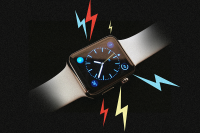On 24 January 1984, Apple Computer introduced the Macintosh. Thirty years later, it’s hard at first to see what is so special about this computer. It doesn’t look much different to other competing products of the time. Housed in a squat gray box, the original Macintosh has a tiny black and white screen, no built-in storage and limited processing capabilities. It was expensive too – costing $2,495 ($5428 today) — and had very few pieces of software available. Plus it was a flop, selling way below Apple’s original expectations.
But the first graphical personal computer changed how we thought about computers, and arguably, set the course for much of the late twentieth century. The Internet, graphical design, photography, film making, music, smartphones, tablets — all of these were created or disrupted thanks to the boundaries broken by the Macintosh. For the first time, the user experience became more important than raw functionality, achieved by the novel concept of using a mouse to push objects around the screen.
The release of the first Mac came after a huge amount of hyperbole, seen best through the $1 million ‘1984’ advert directed by Ridley Scott. With Orwellian overtones, Apple’s then-CEO Steve Jobs saw the Macintosh as a flashpoint in technology and his tool for changing the world:
For Jobs, there was another purpose. Ever since he founded Apple in 1976, he was on a one-man mission to bring down the big beasts of computing: IBM. With ‘Big Blue’ churning out generic machines (powered with Microsoft software), Jobs felt that the Macintosh would be the weapon to slay his bête noire. At the launch of the machine in San Francisco, he said:
‘IBM wants it all and is aiming its guns on its last obstacle to industry control: Apple. Will Big Blue dominate the entire computer industry? The entire information age? Was George Orwell right about 1984?’
He was right in all three instances, although not necessarily through his own doing. George Orwell wasn’t right about 1984. Big Blue no longer dominates the entire computer industry, nor the entire information age. The chain of events he set off lead to the rise of Windows, the market for personal computer clones and the end of IBM’s dominance.
More so than any other Apple product, the machine was a product of its creator. Jobs worked a small team 90 hours a week for over three years to bring the machine to market. The scale of the challenge was huge, and it often seemed they wouldn’t make it. Back in 1984, there simply wasn’t enough power available to do what he wanted.
Andy Hertzfeld, the man responsible for the first version of Mac OS, has written a brilliant account of how the machine came to fruition Revolution in The Valley: The Insanely Great Story of How the Mac Was Made. He portrays Jobs as a narcissist, a bully, a manipulator but a visionary who believed the unrealistic could happen. Hertzfeld also acknowledges that no-one else could have created such a revolutionary product.
Jobs once stated all he wanted to do was ‘put a ding in the universe’. That’s exactly what he did with the original Macintosh. He did again with the iPod, iPhone and iPad decades later but all of them originate from that moment in 1984. For proof of that, walk down any street and see how long it takes to spot an Apple device. Happy birthday, Macintosh!






Comments